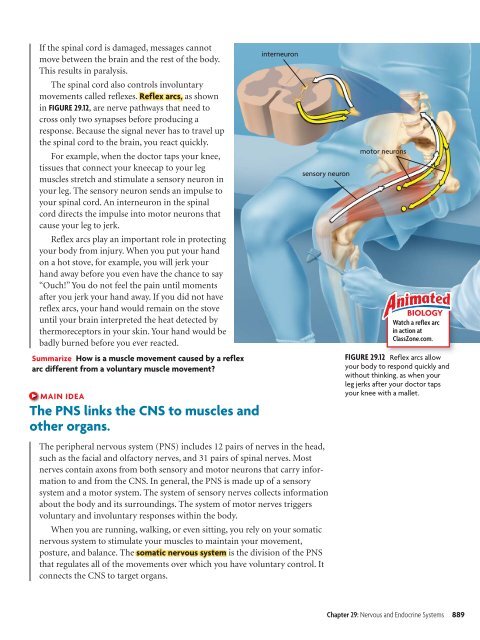Create successful ePaper yourself
Turn your PDF publications into a flip-book with our unique Google optimized e-Paper software.
If the spinal cord is damaged, messages cannotmove between the brain <strong>and</strong> the rest of the body.This results in paralysis.The spinal cord also controls involuntarymovements called reflexes. Reflex arcs, as shownin FIGURE 29.12, are nerve pathways that need tocross only two synapses before producing aresponse. Because the signal never has to travel upthe spinal cord to the brain, you react quickly.For example, when the doctor taps your knee,tissues that connect your kneecap to your legmuscles stretch <strong>and</strong> stimulate a sensory neuron inyour leg. The sensory neuron sends an impulse toyour spinal cord. An interneuron in the spinalcord directs the impulse into motor neurons thatcause your leg to jerk.Reflex arcs play an important role in protectingyour body from injury. When you put your h<strong>and</strong>on a hot stove, for example, you will jerk yourh<strong>and</strong> away before you even have the chance to say“Ouch!” You do not feel the pain until momentsafter you jerk your h<strong>and</strong> away. If you did not havereflex arcs, your h<strong>and</strong> would remain on the stoveuntil your brain interpreted the heat detected bythermoreceptors in your skin. Your h<strong>and</strong> would bebadly burned before you ever reacted.Summarize How is a muscle movement caused by a reflexarc different from a voluntary muscle movement?MAIN IDEAThe PNS links the CNS to muscles <strong>and</strong>other organs.interneuronsensory neuronThe peripheral nervous system (PNS) includes 12 pairs of nerves in the head,such as the facial <strong>and</strong> olfactory nerves, <strong>and</strong> 31 pairs of spinal nerves. Mostnerves contain axons from both sensory <strong>and</strong> motor neurons that carry informationto <strong>and</strong> from the CNS. In general, the PNS is made up of a sensorysystem <strong>and</strong> a motor system. The system of sensory nerves collects informationabout the body <strong>and</strong> its surroundings. The system of motor nerves triggersvoluntary <strong>and</strong> involuntary responses within the body.When you are running, walking, or even sitting, you rely on your somaticnervous system to stimulate your muscles to maintain your movement,posture, <strong>and</strong> balance. The somatic nervous system is the division of the PNSthat regulates all of the movements over which you have voluntary control. Itconnects the CNS to target organs.motor neuronsBIOLOGYWatch a reflex arcin action atClassZone.com.FIGURE 29.12 Reflex arcs allowyour body to respond quickly <strong>and</strong>without thinking, as when yourleg jerks after your doctor tapsyour knee with a mallet.Chapter 29: <strong>Nervous</strong> <strong>and</strong> <strong>Endocrine</strong> <strong>Systems</strong> 889
















